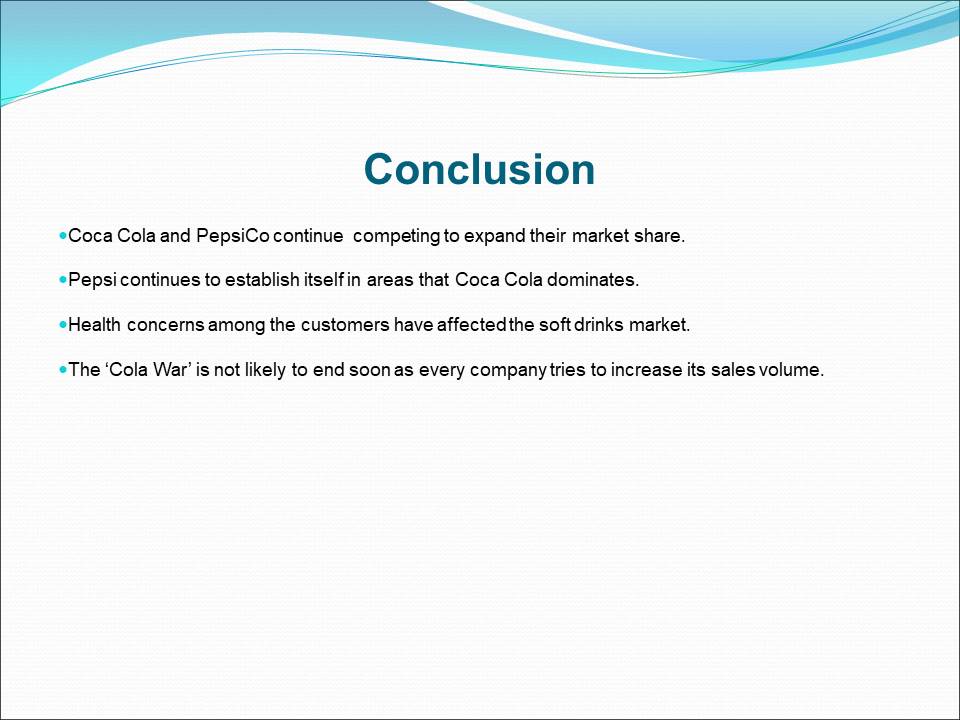Introduction
- The Soft drinks industry has grown due to entrances of new players in the industry.
- Coca Cola and PepsiCo are the leaders in soft drinks market.
- Coca Cola’s headquarter is in Georgia and it operates over 200 companies world wide.
- PepsiCo manufactures carbonated drinks and has numerous brands of non-alcoholic soft drinks across the globe.
The soft drinks industry has grown immensely over the years as different industry players struggle to achieve market leadership and control over their competitors. The Coca Cola Company and PepsiCo are notably the global industry leaders as far as soft drinks are concerned. From high annual profits to huge expenditures in marketing activities and popular brands, Coca Cola and PepsiCo are undoubtedly the unbeatable leaders and players in this industry throughout the world. In their operations and business activities, nevertheless, the two companies have adopted different strategies to strengthen their market positions and activities.
Coca Cola is a multinational soft drink producing company headquartered in Georgia Atlanta (Dost, 2008). Presently, the company operates in 200 countries. Basically, the company manufactures highly concentrated syrup which is sold to various bottlers in different nations (Isdell, 2011).
On the other hand, Pepsi is a renowned manufacturer of a carbonated drink popularly known as Pepsi. The drink changed names to Pepsi Cola and later Pepsi during the great depression era. Currently, the company is operating in different nations with multiple brands of non-alcoholic soft drinks forming a list of widening products (Blanding, 2010).
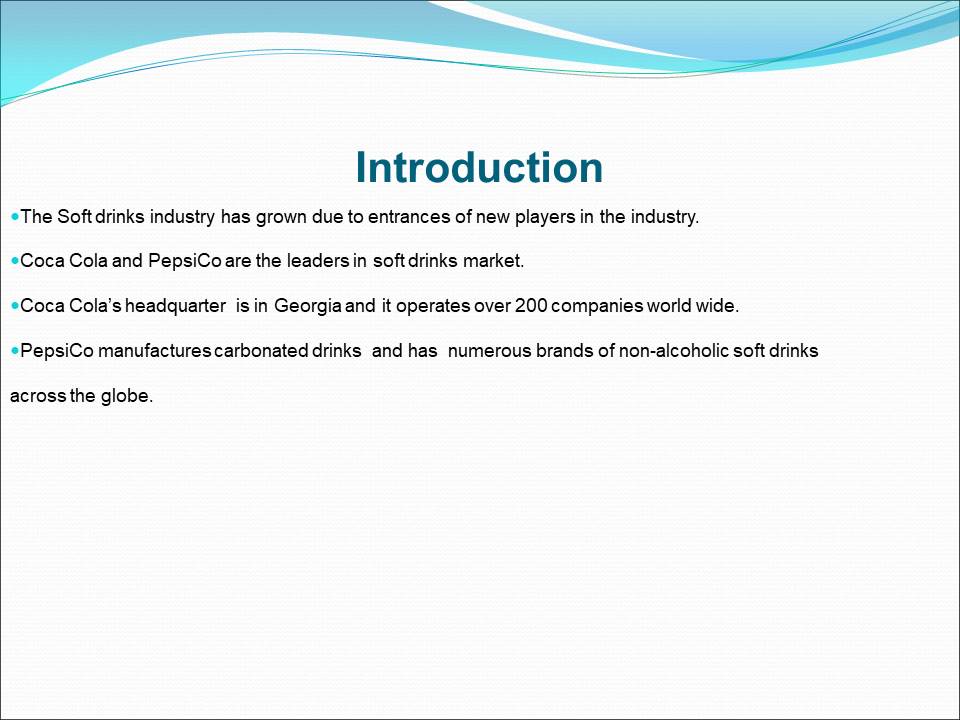
Background Information about Coca Cola
- In 1886, John Pemberton mixed cola nut with coca leaf to get the modern Coca Cola ingredients.
- Initially, the ingredients comprised of fruit syrup and water, but later they replaced water with carbonated water.
- At the start, the company’s sales reached $50, which was less than $75 used to manufacture the drink.
- In 1894, Biedenharn became the first to bottle Coca Cola products.
- From 1905, the company embarked on advertisement and brand differentiation to mitigate competition .
- In 1916, the company opened overseas branches in Cuba, France, and Puerto Rico.
- World War II helped Coca Cola Company to expand into international market.
- In 1978, China allowed the company’s products into its local market.
- In 1985, Goizueta changed the Coca Cola taste for the first time.
Pharmacist John Pemberton in Atlanta, Georgia, accidentally formed Coca Cola in 1886 in his shop as he experimented on formulating a tonic that could cure headaches (Bodden, 2009). The resultant fruit syrup that is today’s Coca Cola ingredient was formed after mixing cola nut with coca leaf, among a collection of other ingredients. Pemberton and his business partner, Frank Robinson, introduced the mixture of fruit syrup and water into the market, with the latter suggesting the name ‘Coca Cola’ to be adopted as the brand name. The two business partners placed the first advertisement of the new product on the Atlanta Journal, with their original catch line being that the beverage was, ‘Delicious! Refreshing! Exhilarating! Invigorating!’ (Bodden, 2009).
The new beverage began selling in Atlanta’s largest drug store, Jacob’s Pharmacy, where it was sold to consumers as soda. Its main ingredients, however, included the fruit syrup and water only. However, it was at Jacob’s Pharmacy that carbonated water was used in the mixture, replacing plain water as an ingredient. Customers liked the new taste, a factor that saw the drink being sold as a carbonated beverage throughout Atlanta (Bodden, 2009). Initial sales only reached $50, which was less than the $75 cost that both Pemberton and Robinson had used in expenses (Bodden, 2009). Pemberton later sold his shares to partners in the business shortly before his death in 1888 following poor health. Asa G. Candler, a doctor and pharmacist based in Atlanta, later acquired the rest of the shares from Coca Cola’s shareholders, spending $ 2,300 in total. The Coca Cola Company was formed the next year under Candler’s watch (Bodden, 2009).
Joseph Biedenharn, a businessperson hailing from Mississippi, became the first one to bottle Coca Cola products in 1894. This set a very important business precedent for the company, which today relies heavily on independent bottlers for its business. Five years later, in 1899, two lawyers Joseph B. Whitehead and Benjamin F. Thomas won themselves exclusive rights to carry out bottling of the beverage and sell out to consumers. The period after 1905 particularly saw the company focus its attention on increased advertisement even as the problem of imitations in the market became imminent (Coca-Cola, 2011). Advertisement messages by the firm stressed on the need for consumers to ensure that they always bought and consumed genuine Coca Cola products and not substitutes. As a way of differentiating itself in the market, Coca Cola opted to introduce a new and distinct bottle shape in the market. The contour bottle, remains to be the signature shape associated with the Company, was first manufactured in 1916. These developments came at the same time when growth of the company was gaining strong momentum, with Coca Cola establishing presence in the international market for the first time in Cuba, Puerto Rico, as well as France (Coca-Cola, 2011).
Coca Cola changed ownership again in 1918 when Candler finally sold it out to Ernest Woodruff. This paved way for Robert Woodruff, Ernest’s son, to take over as the company’s president in 1923. Woodruff’s tenure mainly helped in marketing the brand into the international market. His tenure lasted for close to 60 years, during which Coca Cola built its partnership with the Olympics Games starting in 1928. The World War II was of great significance to Coca Cola, even as Woodruff ordered for a bottle of Coke to be sold at a subsidized price to all US soldiers. It was during the war that the company had the opportunity to expand further into the international market, establishing foreign operations in mainly Europe countries.
New brands were later introduced in the 1960s, with Sprite being established in 1961, while TAB and Fresca being established in 1963 and 1966 respectively. Advertisement also gained momentum in the 1970s when its marketing activities managed to fuse fun, playfulness, together with freedom, altogether. Another milestone by the company was achieved in 1978 when China allowed Coca Cola’s products into its local market as the only marketer of packaged cold drinks. The 1980s, however, saw the leadership at the firm change hands. Roberto C. Goizueta became the CEO in 1981, managing to overhaul the company completely with his ‘intelligent risk taking’ strategy. This saw the several bottling companies in the US form a new public company that was referred to as Coca Cola Enterprises, Inc. The Diet Coke, which has been successful in the market, was also introduced under Goizueta’s watch as the CEO (Coca-Cola, 2011).
The Coca Cola taste was also changed for the first time in 1985, another of Goizueta’s initiative. The focus on international cultures and tastes took center stage under Goizueta’s stewardship, a fact that saw the numbers of Coca Cola establishments in international markets grow to over 200 countries. Other brands that were introduced during this period include the Dasani bottled water in 1999 and Fridge Pack in 2001. Neville E. Isdell took charge of the company in 2004, continuing with the growth and development culture of the company (Coca-Cola, 2011). Additional products have continued to be introduced, including the Coke Zero in 2005, as well as new acquisitions that involved Glaceau in 2007, bringing on board such products as smart-water, fruit-water, and vitamin-water, among others (Coca-Cola, 2011).

Background Information about PepsiCo
- Caleb Bradham founded Pepsi in 1898 after mixing a number of formulas.
- The brand was initially referred to as ‘Brad’s Drink’, but the need for a better marketing name led to invention of the term ‘Pepsi’.
- Pepsi Cola became popular within a short span compelling Bradham to establish Pepsi Cola Company in 1900.
- Increased market demand for Pepsi Cola products led to the company bottling the products.
- Initial advertisements depicted the product as having numerous health benefits.
- Price controls and sugar shortage , during the First World War, led to the company falling bankrupt.
- Loft Candy Company purchased Pepsi in 1931, helping it to regain its influence in soft drink industry.
Another pharmacist, Caleb Bradham, founded Pepsi in 1898 (Stoddar, 2006). After mixing several formulas, Bradham invented the now famous Pepsi, although it was referred to as ‘Brad’s Drink’ at the time. Need for a better marketing name later emerged and the search for a more marketable name began. The name ‘Pepsi’ was coined from pepsin enzymes, which exist in the human digestion system and play a critical role in food digestion. Bradham had a belief that the new drink he had just created was capable of helping in digestion of food, just in the same way pepsin enzymes do. It is, however, not true that the Pepsi drink contained pepsin. ‘Cola’, on the other hand, is a representation of the invigorating and refreshing qualities that are part of the drink (Stoddar, 2006).
Pepsi Cola grew in popularity within a short period, prompting its founder, Bradham, to start the Pepsi Cola Company in 1900 (Stoddar, 2006). Initially, the company only concentrated on selling the Pepsi Cola syrup stores that sold drugs within the eastern areas of North Carolina. The sale of Pepsi Cola in bottles began in 1905 following increased market demand for the product. Franchise agreements between the company and bottling companies were entered to facilitate easy marketing of the product (Stoddar, 2006).
By 1910, up to 240 bottling franchises that involved Pepsi existed, leading to the debut bottler’s convention of the company during the same year. Initial advertisements of the brand highlighted its health benefits to consumers, which went as far as claiming that it helped children grow healthier. With increased sales throughout the years, the company recorded its net income as $31,346 by 1915 (Stoddar, 2006). Its market also widened and covered Virginia, North and South Carolina, Georgia, Alabama, as well as Florida and Tennessee. With the beginning of the First World War in 1914, however, the success of Pepsi was immediately overtaken by tough times. The company suffered losses because of price controls and sugar shortages. Sugar prices increased soon after the war, leading to Pepsi struggling in its business. A pound of sugar retailed for 28 cents, up from 3 cents prior to the beginning of the World War. Bradham, out of fears that the prices would continue rising, bought a huge stock of sugar at 28 cents, only for the prices to fall and retail at the pre-war prices (Stoddar, 2006).
The fluctuations in sugar prices finally led to Pepsi’s bankruptcy. Attempts to revive the company fell flat as Pepsi was eventually certified as bankrupt in May 1923. Pepsi underwent subsequent losses for five years, with different companies attempting with minimal success to revive Pepsi. The Loft Candy Company acquired Pepsi in 1931, with Charles G. Guth, its president, assuming command of the beverage manufacturer. Pepsi gradually regained its strong footing in sales, increasing the number of its franchises in 1936. Introduction of new brands under the Pepsi flagship, as well as expansion of the international market has continued throughout the years as Pepsi has grown to become an internationally renowned beverage brand (Stoddar, 2006).
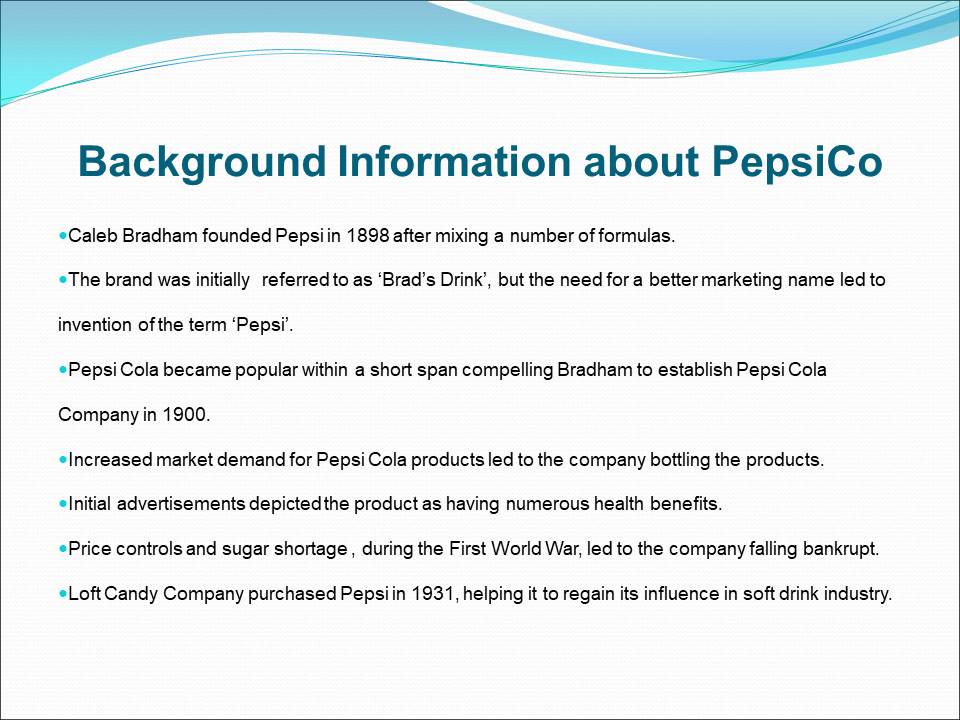
Literature Review
Use of Renowned Celebrities
- Modern marketing is adopting the use of famous celebrities in marketing campaigns.
- Coca Cola has initiated a program dubbed ‘Perfect Harmony’ that helps to popularize upcoming artists.
- The company targets millions of hip-hop and R&B music fans across the globe.
- In 2011, Coca Cola used Natasha Bedingfield, a popular R&B artist to market its products.
According to Hsu and McDonald (2002), modern marketing methods have continuously adopted the use of famed celebrities in their advertisement and marketing campaigns. This idea is particularly preferred because celebrities can turn out to be successful spokespersons, both for the company as a whole or its specific brands in particular. Coca Cola has even initiated a whole program dubbed ‘Perfect Harmony’ music platform, which seeks to provide young and upcoming artists an opportunity to launch into stardom (The Coca-Cola, n.d.). The artists compete on popular TV shows in their bid to outshine each other and win the coveted prices. The Coca Cola has traditionally looked at music as a perfect way of creating market awareness for its products not only in America, but also throughout the world.
In the ‘Perfect Harmony’ initiative by the soft drinks manufacturer, a partnership with 106 & Park television show provides the artists with a worldwide viewership and audience. The show is a flagship of the BET AWARDS, which is also shown on cable television (The Coca-Cola, n.d.). The millions of hip-hop, as well as R&B music fans both in America and throughout the world, who follow these programs are the target market for Coca Cola. Because these fans have a passion for music and possibly for their favorite contestants, it is easier for them to connect with Coca Cola as a brand because of the sponsorship program. Cable TVs are a new phenomenon that has revolutionized the entire TV industry and market. Viewers, supported by the internet, are able to watch their favorite programs without necessarily being curtailed by physical distance and location, which are factors that determine the outreach of traditional TV.
In November 2011, Coca Cola tapped the services of Natasha Bedingfield, a famous R&B artist, to help in its marketing campaign. The “Shake Up Christmas” rendition was sung by the artist in six different languages to highlight Coca Cola’s key message for Christmas. To highlight how global the company is, Coca Cola relied on Bedingfield’s flair of languages, which saw her record the holiday anthem in English, Swahili, French, Ukranian, Spanish, and Filipino. This was part of Coca Cola’s ‘Open Happiness’ marketing campaign that spread across the globe to cover up to 90 countries (The Coca-Cola, 2012).
Non-Celebrity and Lifestyle issues Campaign
- PepsiCo uses a different approach to market its products.
- Initially, the company used celebrities in its marketing campaigns, but it changed the strategy in 2003.
- The company seeks to position its products as the main hero, thus creating the perception that it manufactures perfect products.
- PepsiCo used a marketing campaign that was full of stars, humor, jingles and other effects between 1999 and 2003.
- The company used celebrities to create market awareness and attract customers.
The PepsiCo advertisement has taken a different approach from the use of celebrities and lifestyles as has been synonymous with Coca Cola. Although PepsiCo, like its rival Coca Cola, previously used different celebrities in their marketing campaigns, a different strategy has been adopted since 2003. The change of strategy, according to the company, seeks to portray PepsiCo products as the hero and not something or somebody else (Elliott, 2003). Additionally, the idea of leaving out celebrities and focusing on building the products as the main hero aims at presenting Pepsi as a perfect accomplishment that users must consider for their snack chips, pizzas, and hot dogs (Elliott, 2003).
For a long period, between 1999 and 2003, PepsiCo had embarked on an aggressive marketing campaign that saw its advertizing message and material fill up with stars, jingles, humor, and other special effects. ‘The joy of cola’ marketing theme used in 1999 and which later changed in 2001 to ‘The joy of Pepsi’ focused on celebrities as the main way to create market awareness and attract customers (Elliott, 2003). Pepsi’s senior vice president, also doubling up as chief marketing officer, David Burwick, explained the main reason why the company was changing their strategy at the time. There was need for Pepsi to highlight the fact that it greatly matched with food and social occasions (Elliott, 2003).
Market Positioning/source
- Coca Cola and PepsiCo value market positioning.
- Both companies started focusing on market positioning in 1980.
- Coca Cola uses market positioning to strengthen its brand .
- PepsiCo uses market positioning strategy to position its products as ‘substitute products’.
- PepsiCo’s focus is based on global and international view.
- Coca Cola focuses on establishing a long-term influence in the soft drinks industry.
Historically, Coca Cola and PepsiCo have been known to pay a lot of attention to the question of market positioning for their respective brands. The frequent changing of marketing themes for both companies highlights their different strategies and approaches to marketing. A focus on the recent days and times explains how the two companies have been using different approaches, using their marketing themes.
According to Moraru (2010), the period beginning 1980 represents what is known as ‘The Corporate Era’ in the inner circles of both Coca Cola Company and PepsiCo Inc. This is a period where the brands are establishing their positioning even as competition maintains its prolific stance. Both companies put a lot of emphasis on the policy of management that they adopt, as well as working out on their international image (Moraru, 2010). A series of the different marketing themes used by Coca Cola and Pepsi during the corporate era also highlight the different marketing strategies pursued by both companies. They underline the focus by both companies on their market positioning.
Moraru (2010) proceeds to deduce the exact positioning for both companies by analyzing the themes adopted. Coca Cola, for instance, uses its themes to insist on the image that is traditionally associated with it. The positioning emphasis is based on time, particularly with the 1993 theme, ‘Always Coca-Cola’ (Moraru, 2010). The brand also adopts a market position that puts more emphasis on lifestyles, owing to the double meaning of taste, which is the quality of the product and the social aspect. The Coca Cola theme of 2009 attempts to introduce another new feeling, that of happiness, which implies a market positioning that is founded on surprise expectations (Moraru, 2010). The Coca Cola commercial known as, ‘Happiness Factory’ clearly highlights this reasoning, with its main purpose being to formulate the mechanical instrument through which the ideal in life can be attained (Moraru, 2010).
Although both brands use ‘taste’ in their different themes, the approach by Pepsi is very different. The implied meaning of the company refers to living life as a challenge, where the feeling of ‘forever being young’ is actually tasted (Moraru, 2010). The emphasis of Pepsi is to position itself as a ‘substitute product’, most definitely for Coke (Dupont, 1999), and as a replacement for virtually everything. The mention and comparison made to sex seeks to cement the reasoning that no pleasure on earth can actually replace that of Pepsi. Both brands, however, focus on their consumers being happy, which displays their interest in the spirit of the consumer. An in-depth analysis of the themes used by the companies, including those adopted in the early days of their competition in 1900, points at the fact that Coke only refreshed consumers.
On the other hand, Pepsi focused on covering the whole world, a factor that helped Pepsi acquire the autocracy sign in the market (Moraru, 2010). Pepsi appears to have adopted the old opposition strategy previously used by Coke by seeking to identify itself as the original Cola in the market. The theme adopted, ‘Pepsi. It’s the Cola’, emphasized the fact that the brand is the only deserving Cola in the market, despite the fact that Cola is actually part of Coca Cola (Moraru, 2010). Additionally, Pepsi’s focus is based more on international and global view, where it attempts to offer something unique for everyone. This is particularly informed by the multicultural world, which requires that products should always consider breaking their initial border. The same, however, cannot be said of Coca Cola, whose focus is on fighting for time’s authority strongly. Coca Cola is seeking to achieve the tag of constantly being ‘the real thing,’ particularly because it has been, for years, relatively successful in earning the international status (Moratu, 2010).
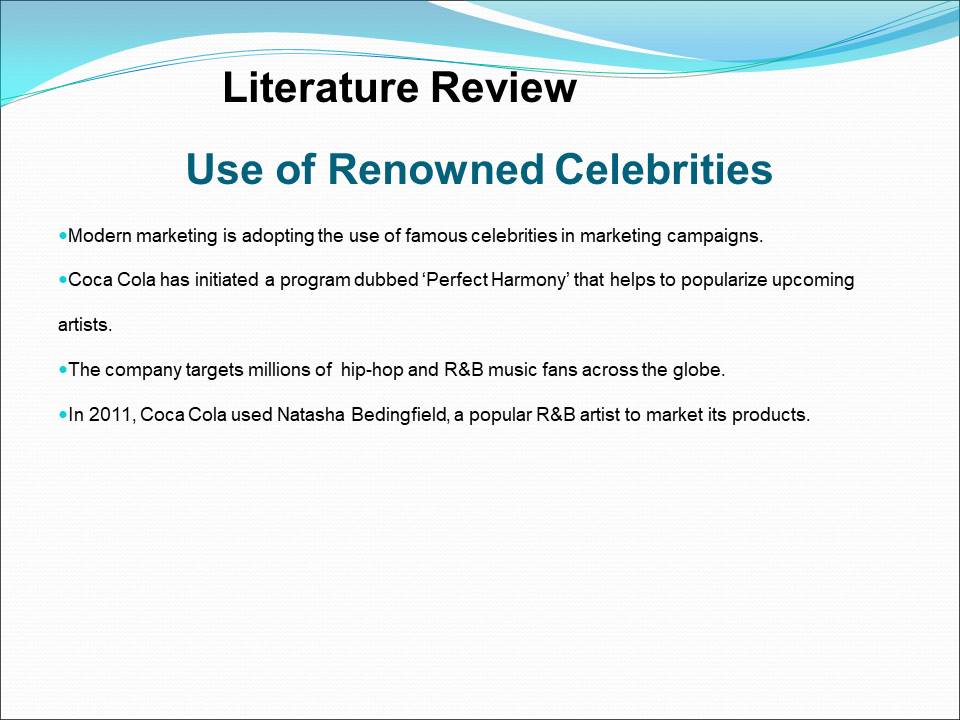
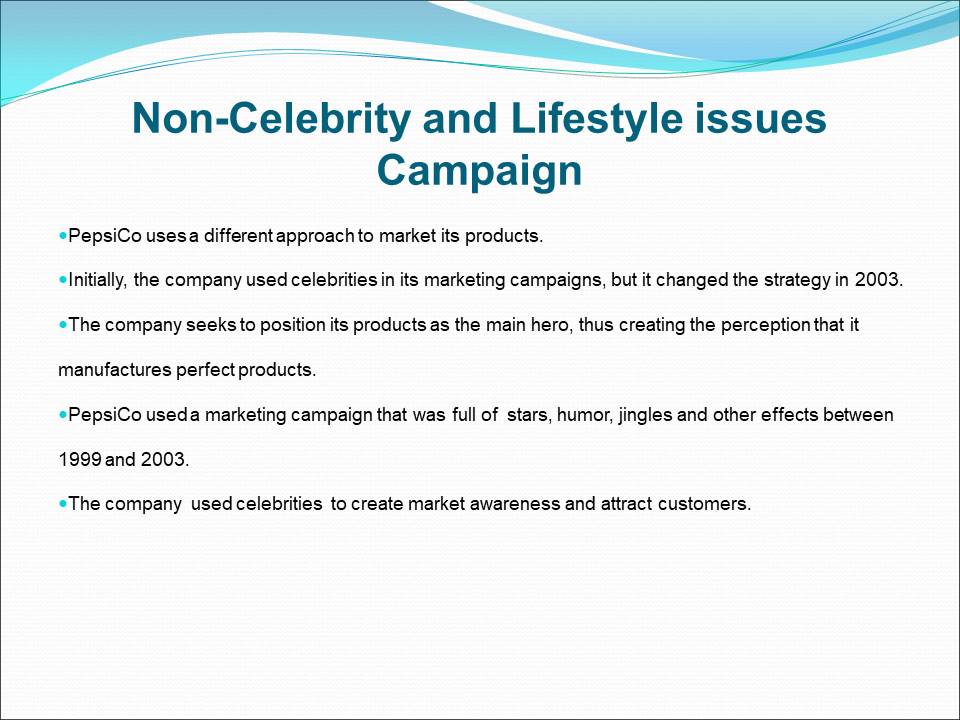
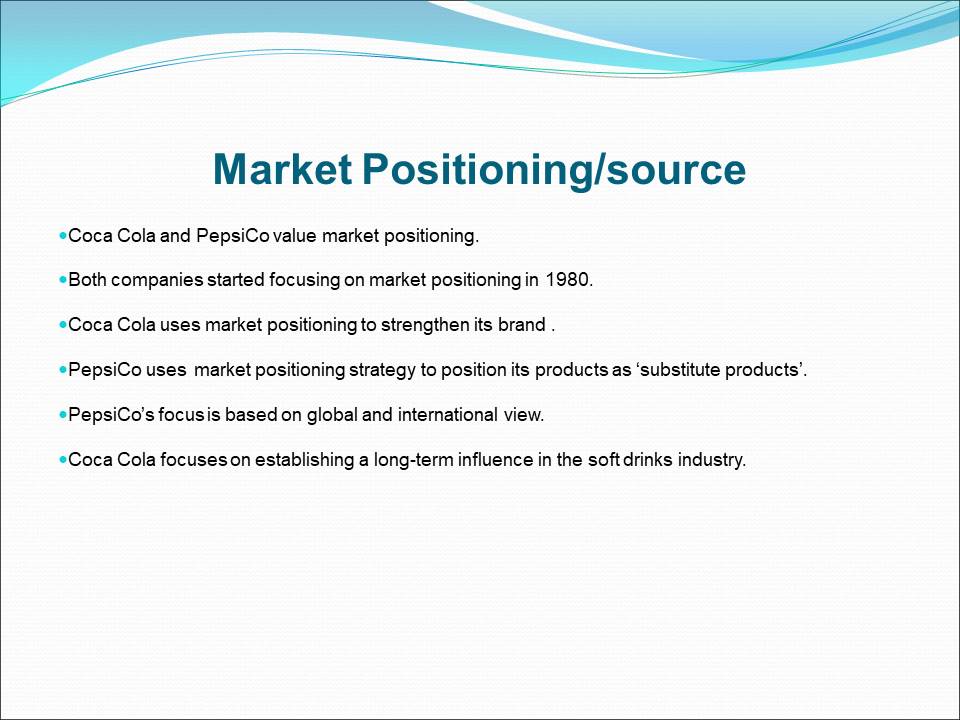
Analysis of Results
Social Media Marketing Strategy of Coca-cola and PepsiCo
- The Cola war between PepsiCo and Coca Cola has taken a new dimension in modern information technology epoch.
- The companies use technology to outdo one another in the soft drinks industry.
- The companies cannot expand their soft drinks market in many countries, and thus, they use social media to maintain their market share.
- In 2010, PepsiCo invested heavily in social media advertisement gaining brand disclosure.
- Coca Cola did not manage to capture the market through social media advertisement.
Liu & Smit (2012, p.1) pointed out the Cola War between Coca-cola and PepsiCo has gained a new shape in the modern information technology era, the tradition battle of brand competition sustained over their distribution channels, advertising media, retail outlets, and sports event organizing, but now it has gained a new media to continue their fighting through social media. The battlefield of Coca-cola and PepsiCo war has evidenced in the USA and China that pointed to the insights of the companies how ugly their fighting are they have engaged to identify new way of competition in the social media platform by engaging huge investment to assemble a reliable and logical brand image by damaging one another online. Although the adoption of social media strategy of the both companies is very different, but the aim and objectives are same, both of the companies intend to gain long-term and short-term returns from the investment in this new media with the changing dimension of beverage market globally. The reason behind their irrevocable competition and investing in the social media marketing is that the fortunate time to expand the carbonated beverage market has possibly ended; in the highly consumed countries like USA, it has evidenced negative growth from the starting of this millennium. Moreover, the lower consumed countries has little growth but not in a satisfactory level for instance, it was predicted that from 2005 to 2010 the growth would be 7%, but it actually gained less than 1% with a per capita consumption of one twentieth of the US market (Liu & Smit 2012, p.1).
In 2010, the PepsiCo reduced 50% of its traditional branding budget and moved that investment to the social media to promote ‘Pepsi Refresh Project’ that urged people to explain their views to ‘refresh’ the society where the company would make financial contribute to encourage the highest voted idea. At the same, time Coca-Cola explored 206 social media campaign in different platform to promote ‘optimistic and happy’ for a year where the highest voted concept would get ticket for Olympic Games 2010 and facilitate them to participate in the new cast from the game fielding Shanghai. In that social media campaign, PepsiCo has gained more extended brand disclosure through its ‘refresh the world’ and was capable to create a center of attention for particular consume group while the social media campaign of Coca-Cola has gained very poor attention of the customers where very unsatisfactory figure of fans and followers integrated their options in the campaign.
Brand promotion and pricing strategies of Coca-Cola and PepsiCo
- In 2013, PepsiCo sponsored the Indian Premier League to help it in promoting its brand image in the Indian Market.
- Coca Cola has come up with reduced pricing strategy to counter PepsiCo in the Indian market.
- Coca Cola Company sets its prices based on those of the competitors.
- Coca Cola lowers its prices to capture new markets.
- Both Coca Cola and PepsiCo use Pricing discrimination strategies.
- The companies sell their products at different prices in the various countries.
Bhushan (2013) pointed of that PepsiCo was aggressive to be the title sponsor of the IPL(1) 2013 and purchased the sponsorship for the next five years for Rs 4 billion at the rate Rs 800 million per year, the company further spent RS 600 million to be one of the two presenting sponsor with TV channel. The channel SET Max has allows maximum airtime channel for PepsiCo at the time of IPL broadcast, the company also became drinking partner of the tournament for RS 100 million with the aim to promote its brand image in Indian market while the brand experts in India have identified it as a bulk investment for brand promotion. To encounter such bulky branding strategy, Coca-Cola presented a reduced pricing strategy during the IPL tournament and conducted the advertising campaign “Refreshment at Rs 8” with the believe that customers would positively drive to the low price offer without looking to the sponsorship deals of the rival PepsiCo. Coca-Cola explained that the company has taken into account of the market reality of summer season while the market demand goes higher and its communication strategy has aimed to demonstrate that the company is giving a tremendous cost saving opportunity for consumers that would supersede the heavy invested barding strategy of PepsiCo. In the Indian market, brand promotion strategies of the two companies have evidenced that PepsiCo has aligned with high investment intensive branding strategy while the Coca-cola followed the lower pricing strategy to encounter its rival in the Indian market.
The CEO, management team, and board of directors of Coca Cola have decided that they will set price considering the competitors price, but it must be affordable to the customers (Lin 2012; and Fourni 2012). According to the annual report 2012 of Coca cola, it is truly a global company, which is successfully carrying on business for more than a century; however, pricing strategy plays a vital role to experience tremendous accomplishment. At the time of global recession, the marketers had analyzed the global market condition to many pricing decisions with intent to maximize shareholder value and to grab market share; however, it is important to notice that the decision-makers of this company decreased the price of the some products (like reduce price of 200ml container), but not all products (Fourni 2012). At the same time, this company uses lower price to enter new markets, which are particularly sensitive to price to meet the competitive forces and to increase brand awareness among the target customers; moreover, it focuses on the brand-positioning map, moment of joy & happiness, and other cultural factors (Fourni 2012).
Carbonated Soft Drinks industry in the global market is mature enough due to large population growth and the amount of promotional activities; however, these companies have resorted to pricing discrimination strategies to exploit the value of customer demand (Angelkov, Black & Green 2003; Rappeport 2011 and Golan, Karp & Perloff 1999). Furthermore, direct price discrimination is one of the most common pricing strategies to Pepsi and Coca Cola; however, the companies like to apply this strategy to set price of the products because the price structure under this system based on the location and purchasing power of the customers (Angelkov et al. 2003, p.5). The price of Carbonated Soft Drinks of different companies in Mexico, Bangladesh, India, China and other Asian countries are lower than prices in the US even though the manufacturing cost is almost same; however, it also depends on distribution channel and supply chain management (Angelkov et al. 2003, p.5; and Golan et al.1999). Furthermore, the management and marketers of these two companies have concentrated on several factors related with costs in the supply chain, unit base pricing system, and so on (Angelkov et al. 2003; Rappeport 2011 and Golan et al. 1999).
Market Expansion Strategy
- Coca Cola aims at increasing the number of its customers by two billion by 2020.
- Coca Cola targets middle class people in rural areas.
- It intends to invest US$30 billion in the global market to help it double its current revenue.
- PepsiCo intends to invest in advertising and marketing strategies.
- PepsiCo also aims at implementing a multi-year productivity scheme to help in reduction of operations costs.
- The company intends to expand its Chinese market.
- PepsiCo aims at using both horizontal and vertical expansion strategies to gain competitive advantage in the global market.
Stafford (2013, p.1) pointed out that the market expansion strategy of Coca-Cola has aimed to add new 2 billion customer by 2020 all over the world and it has targeted the middle class people in the rural area as well as farming neighborhoods to the big cities where the products are not yet expanded. To implementing such high ambitious market expansion strategy, the company proclaimed that it will investment further US$ 30 billion in the global market within the next five years, the motivation of such big target has empowered by its vision 2020 that aimed make its revenue twice over than the 2010 which was 100 billion. The market expansion strategy has aimed to emphasis on the market of India and China where Coca-Cola products are not yet reached due hazardous communication, transportation and electricity supplies, but the area have more population density in the remote rural areas. The company thinks that within a decade, by eradicating poverty and corruption the rural areas of those market would gain an infrastructural development especially road communication and electricity which is the top priority of those governments and the people of those areas would be interested to spend money for carbonated beverages.
On the other hand, PepsiCo (2012) announced its market expansion strategy arguing that it would boost advertising and marketing efforts in the global market by investing additional US$ 500 to US$ 600 million during 2012 with special attention to the US market where it is accelerating in a smooth way, the company expects that it would result higher revenues growth. At the same time, PepsiCo aimed to implement Multi-year productivity scheme intended to engender US$1.5 billion of cost savings within the year 2014 by reengineering the operational practices and implementing structural changes that would reduce around 8,700 of its working force, which is the 3% of its present global employees. Stafford (2013, p.1) added that PepsiCo also emphasized on the market expansion in China arguing it as the numbered one market next to the USA and planned to invest bottling project with a joint venture with local beverages company, the company would also expand food manufacturing plant in China and India.
According to the annual report 2012 of Pepsi, this company considers both horizontal and vertical expansion strategy to gain competitive advantage in the global market place, but it failed to manage company in different regions because of taxation policies of the governments, adverse economic condition and so on. As a result, the survey reports have not demonstrated the actual position of this company since secondary data sources explain that market expansion strategy is difficult to control for this company.
Business Level Strategy and Positioning of Product Line Extension
- Coca Cola uses differentiation strategy to maintain the uniqueness and specialty of its products.
- Its hard for rival companies to copy Coca Cola products.
- PepsiCo implements its differentiation strategy at business level.
- The company produces varied soft drinks recipes for different markets across the globe.
- Coca Cola and PepsiCo have numerous products that target remarkable market segments.
- Coca Cola’s Thumps Up and PepsiCo’s Mountain Dew target consumers who are adventurous.
- Both Coca Cola and PepsiCo have products that target consumers who are health conscious.
BenLud (2013) has engaged his effort to identify the business level strategy that Coca-Cola applies at its operation and pointed out that that the company engages to adopt differentiation strategy to uphold its uniqueness as well as specialty of its products over the other market players. By adopting differentiation strategy, Coca-Cola prepares its carbonated beverages along with services in a unique and valued way, which the competitors could not copy, the company provides huge non-priced attributes those customers get as a premium sanctioned by this global beverage giant. At the same time, the company differentiates operation through its dignified and unique marketing approach, exceptional advertising campaign, diverse bottle shapes, increasing customers satisfaction and strong brand loyalty that there is none competitor to encounter with the higher degree of differentiation that Coca-Cola put into practice. Another remarkable differentiation strategy of the Coca-Cola is its ‘Freestyle machine’ that facilitates the customers to mix up the traditional beverages with numerous special flavors, the company also continues its research and development project to engage with further differentiation in order to continue its dignity superior than other competitors in the market
Karanis (2013, p.1) explored that the corporate level strategy of PepsiCo has been providing its customers a diverse range of products and services with strong brand gratitude that generating from the company’s business level strategy strongly aligned with differentiation, while its rival Coca-Cola practice the business level strategy at its global operation. The company always keeps its efforts to bring newer product range in the market in order to deliver competitive advantage for PepsiCo, in every business units of the company in the food and beverage sector including its Asian, American, European, and African operation it has engaged same degree of business level strategy. The business level strategy of differentiation at relevant geographical regions of PepsiCo guides the functional level strategies to emphasis on innovation in order to generate new recipes from different elements like enzyme pepsin that assist people to meet the requirement of digest and to boost necessary energy level. At the same time, the business level strategy of PepsiCo has amalgamated with the lower cost differentiation that generates economic scale of advantage in the course of its mass production of different products with dissimilar variety of test and flavor from the competitors.
Mittal (2010, p.27) pointed out that both the companies PepsiCo and Coca-Cola have a variety of products into their basket those are targeted to unusual market segments where they feel difficulties with regular items and the positioning are completed in that way where the brand gain attributes to address any segment of the society of localization smell for consumers. For instance Coca-Cola’s Thums Up of and the Mountain Dew of PepsiCo have targeted to address the exploratory as well as energetic individuals who are paying attention to adventurous events and devoted to encounter with risk to bring success, the advertising theme of the both brands have tried to position consumer’s mind that they are taking ‘strong’ soft drink. PepsiCo’s product ‘Gatorade’ has aimed to position at the mind of sporting people and the company introduced it as a sports drink and gained tremendous success in the market, but unfortunately its promotion has mostly constrained in the sporting events due to propagate it as a sports drink. The ‘Minute Maid’ of Coca-cola and PepsiCo’s’ Tropicana’ have developed to meet the demand of health conscious customers and introduced them as health drink that contains natural energy, both the drinks introduced within the class of fruit juices with the intention to divert customers from another segment who aligned with fruit juice producers.
Sponsorship/ new product development
- Sponsorship is a commercial activity that enhances brand awareness and increases sales revenue.
- Coca Cola and PepsiCo sponsor different sporting events to popularize their products.
- Coca Cola carries out research and development to help in manufacturing quality products that can withstand competition.
- The company keeps on introducing new products into the market that target different market segments.
- PepsiCo established a research laboratory to help in producing healthy products.
- It works in collaboration with Yale School of Medicine to equip its employees with skills in nutrition.
Many researchers have pointed out that sponsorship is mainly a commercial activity where the sponsoring company gets right to promote groups with the sponsored object intended to get benefits; it is the underwriting of a particular event to support business goals by enhancing commercial image, growing brand awareness, inspiring the customer and increasing sales revenue (Andersson, Arvidsson & Lindström 2006). At the same time, there are many issues involved to generate profits, so, the multinational companies concentrate on the sponsorship activities, such as, development of brand awareness along with brand image, and corporate image; however, the companies also using numerous advertising techniques which planned to expose the sponsoring brands to attract potential customers (Andersson et al. 2006). On the other hand, event sponsorship (sports, music, and festival related event) has become extremely popular; however, sports sponsorship is the most common sponsorship activity to Pepsi and Coca Cola (Andersson et al. 2006).
Coca-Cola (2012) reported that the company is always eager to changing the elements of its bulk production of carbonated beverages with a complex progression through vast research and development in order to overcome associated challenges process, the special attention has given to reduce the level of sugar and calorie contented into soft drinks for great taste and health safety. From 2007 up to now, it has reduced the calories of different products from 30% to 56%, the eighty years old brand ‘Fanta’ has evidenced with almost ninety different tastes and flavor, and in 1997 it launched “Diet Fanta Orange” as a sugar free edition of the beverage. In 2004, with an improves taste the same brand came in the market in the name “Fanta Orange Zero” that gained higher customers preference, the process of new product development is an ongoing process for Coca-Cola and it is now working to improve Fanta like “sweet-tasting orange” for the customers of the UK market. The company also keeping its continuous efforts to substitute the sugar with an improved organic ingredient Stevia produced from the leafs of plants that contains zero calories, instead artificial colors the company is very careful to replace them with natural color from carrot and pumpkin, the combination of such organic elements would assist to enhance its health conscious customer base.
PepsiCo Inc. (2012) announced that the company has established a state of the earth research laboratory in order to develop new products extremely healthier than its competitors in the carbonated beverage, and packaged food market, at the same time the company introduced graduation fellowship course at Yale School of Medicine in order to support its research and development. The company would like to be the pioneer of nutritional science research and implication other than its competitors that would generate enhanced competitive advantage for PepsiCo in long run in order to shift to the healthier assortment of new products in the foods and beverages industry. The new product development attributes of PepsiCo has evidenced with reduction of 70% fat and utilization of fresh premium orange juices along with reduced amount of preservative for its product line that would enhance the health conscious people to choice its brand.
Cultural factors/ Supply chain management
- Brand positioning influences consumers’ decisions.
- Brand positioning has helped Coca Cola and PepsiCo to capture market in the Kingdom of Saudi Arabia.
- Mecca Cola, a Saudi Arabian company depicts Coca Cola and PepsiCo as anti-Muslim to overcome them in the market.
- Despite Coca Cola and PepsiCo using somewhat similar pricing strategies, Coca Cola performs better than PepsiCo.
- Coca Cola products are sold in many food outlets and retail stores.
Mittal (2010, p.29) also added that positioning assist to generate a particular space into the consumers mind, if a company could able to position its products at the exact attention of customer would deliver very interesting outcomes, in the soft drink market there are huge scenario of multination are being localized. For instance, Coca-Cola and PepsiCo are both have long historical entry in the KSA where Mecca cola is another local soft drinks with littlie market share and was unable to position in the market by struggling with Coca-Cola and PepsiCo who have large market domination , due to their marketing performance the sales of Mecca cola was decreasing. Suddenly Mecca Cola started to propagate that both Coca-Cola and PepsiCo are the US originated company and the companies are enemy of Muslim, thus they called for boycott their soft drinks. By generating anti American sentiment and radical Islamic approach, the Mecca Cola was capable to position itself as soft drink for Muslims and gained a remarkable market share by passing back Coca-Cola and PepsiCo far apart.
Lin (2012) stated that taste and pricing of the products of Coca Cola and Pepsi are almost similar, but the position of these companies is not same in the global market, for instance, sales revenue of Coca Cola is five to six times greater than Pepsi in the whole market. Most interesting, in the time of present global financial crisis, Pepsi faced enormous challenges for liquidity crisis though it responds appropriately on time; in addition, in the past the great depression, Pepsi went into bankruptcy twice (Lin 2012).
However, Coke is available everywhere compared to Pepsi, such as, in every food outlets of McDonalds, Starbucks, KFC, and other fast food stores; however, Coke is widely available within a smaller radius for which the people of both rural and urban areas can purchase Coca Cola products (Lin 2012). In addition, the purchasers of soft drinks not bother about their drinks, but they want to save time and effort; considering this benefit, a consumer would purchase Coca Cola products more often though many other issues that make it dominant over Pepsi for example its pricing strategies, marketing policy, packaging and so on (Lin 2012).
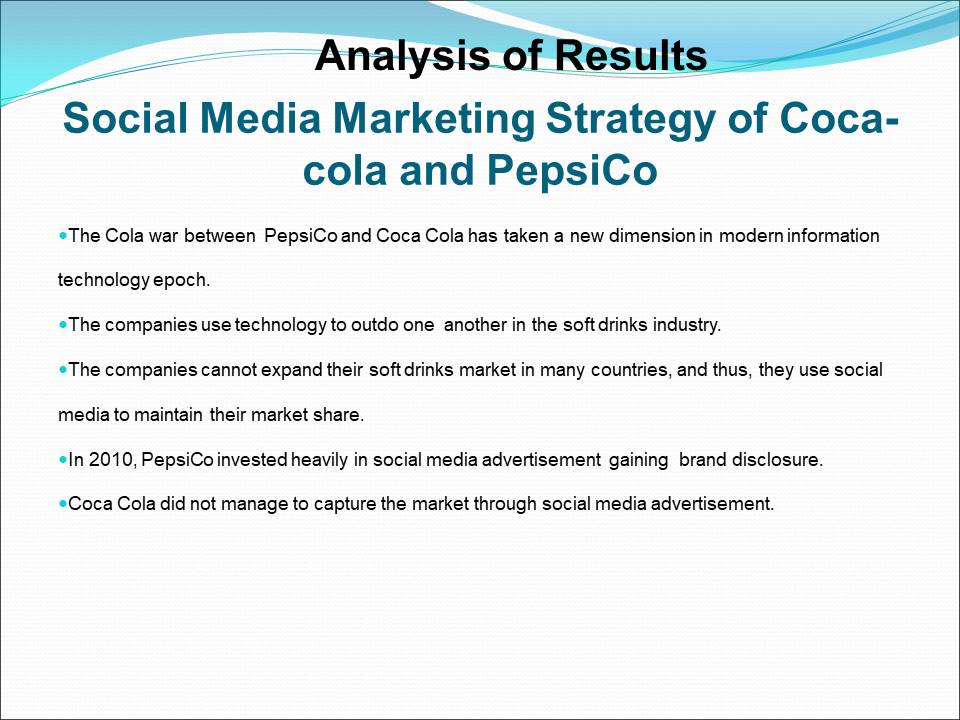

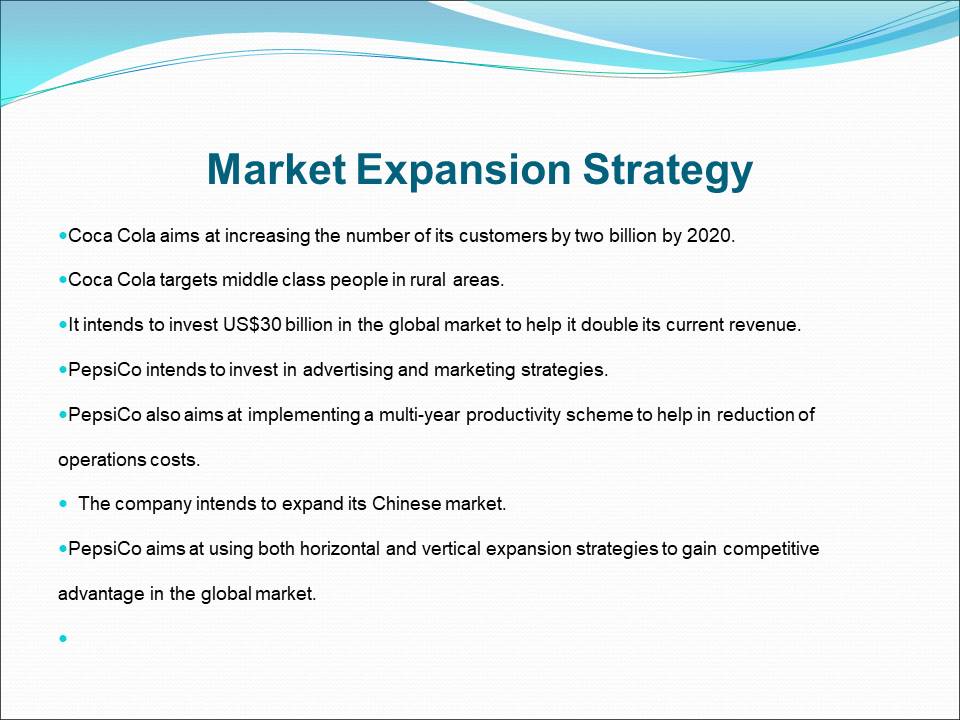
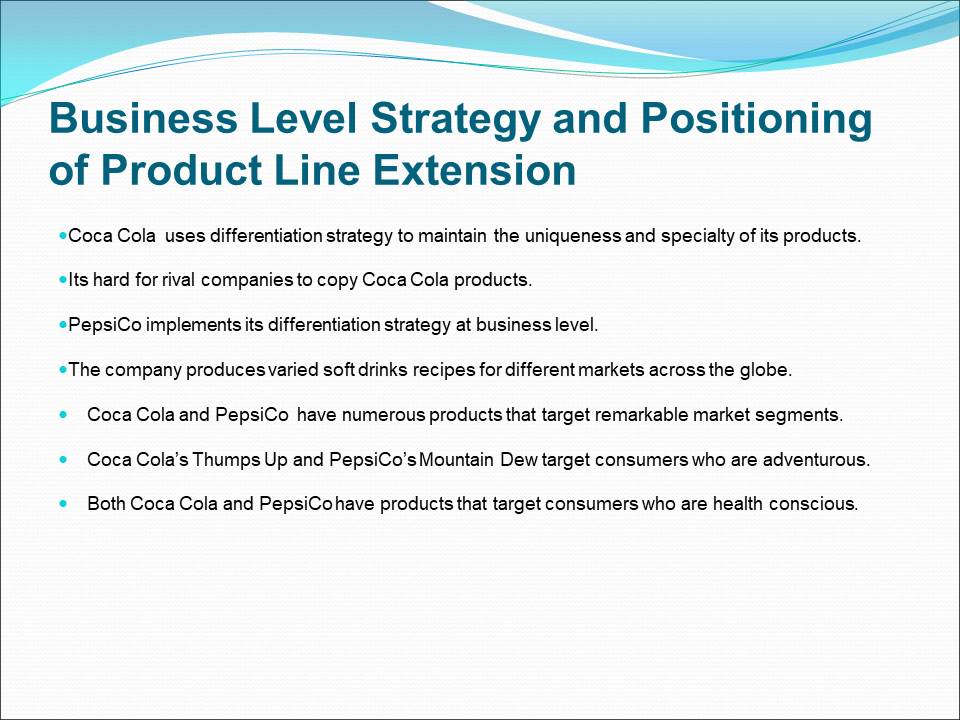
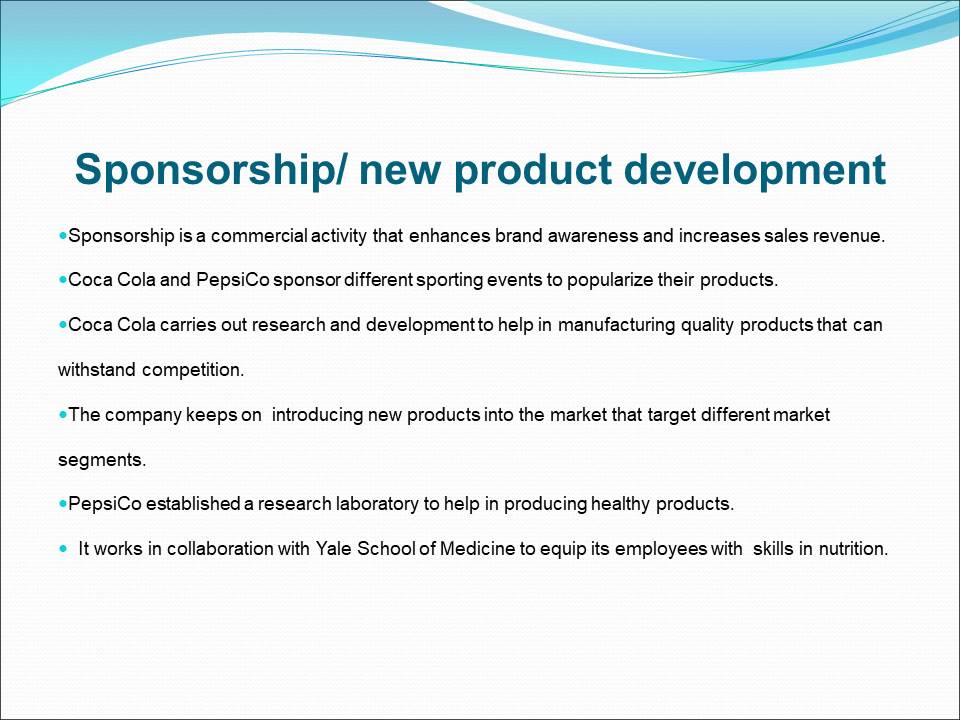
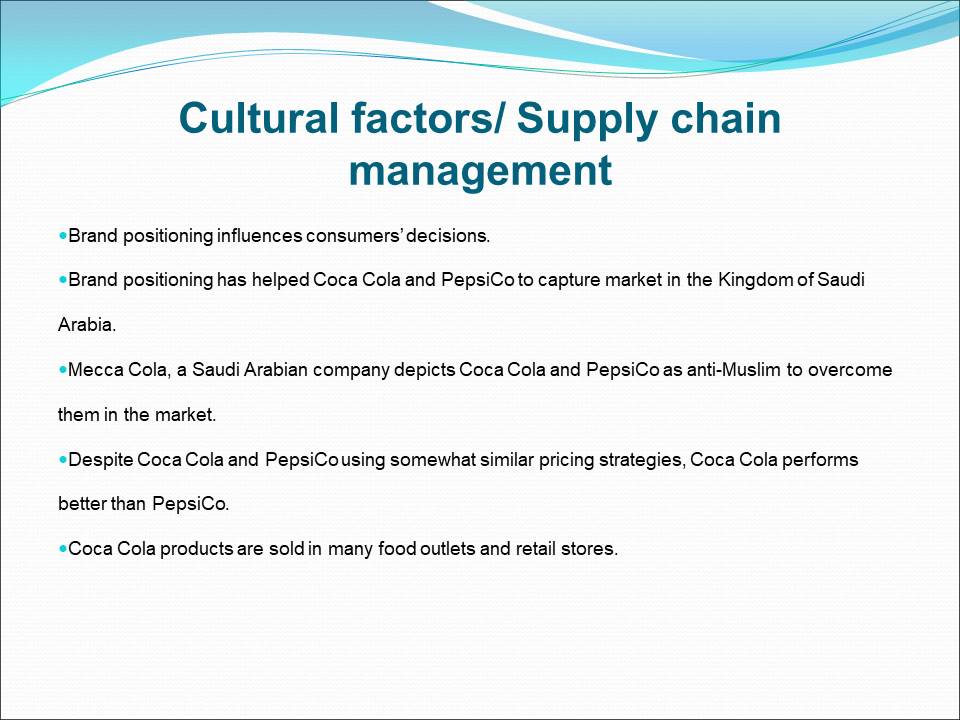
Findings, Conclusions, and Recommendations
Summary of Findings
- Past study focused on consumer preference, cultural and marketing factors, and diversity management.
- This study focuses on the marketing strategies used by Coca Cola and PepsiCo companies.
- The study evaluates how marketing strategies help Coca Cola and PepsiCo to position themselves in the global market.
- The study suggests that PepsiCo performs poorer relative to Coca Cola due to its late entrance into the market.
Previous research on the carbonated soft drinks industry mainly concentrated on the different factors related with consumer preferences, effectiveness of advertising campaigns, estimating pricing strategies of Coke and Pepsi, cultural factors to operate business in different countries, diversity management system, and financial analysis and so on. However, this research paper contributes to the body of scholarly knowledge by providing new findings about the different strategies used in Coca Cola and Pepsi while the researcher considered the standpoint of consumers and workforce of these two companies. There research question was the extent to which business level strategy, pricing strategy, brand promotion strategy, NPD and market expansion strategy are effectual to manage Coca-Cola and Pepsi in the global market; however, hypothesis based on Pepsi’s late introduction into the market, relative to its competitor Coca Cola, is the main reason behind its comparatively dismal performance in the market.
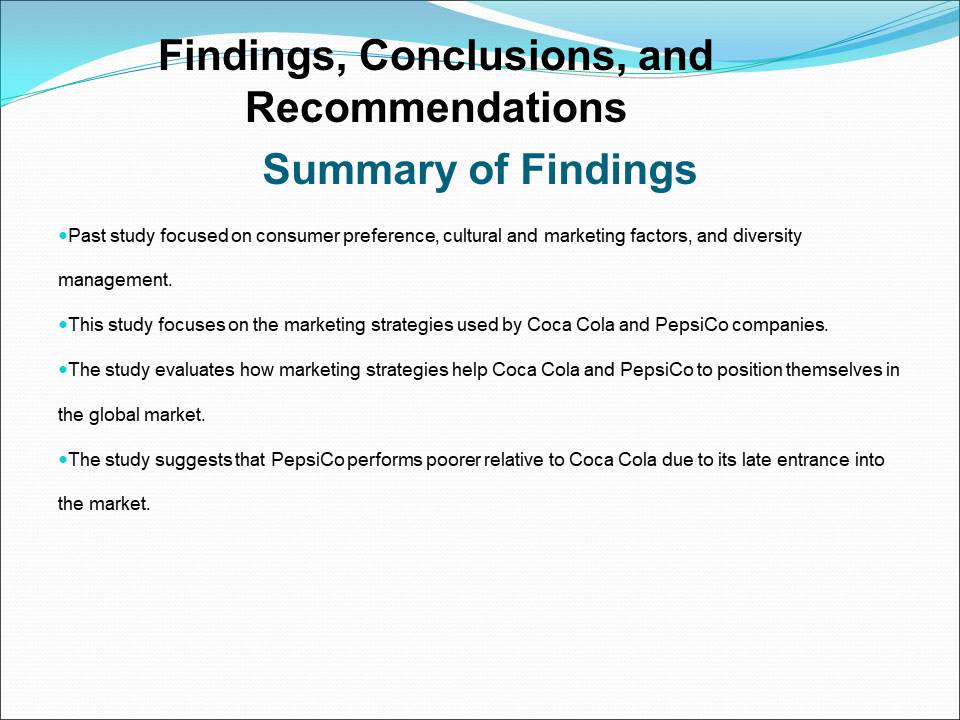
Limitations
- Data collection was a major limitation in this study.
- Collecting data from a single country could give misleading conclusions and recommendations.
- It was hard for researchers to cater for reliability and validity of the study.
- Researchers did away with some of the questionnaires.
- Researchers could not cover the entire topic of study.
- Some participants were reluctant to share crucial information.
- The research findings cannot be generalized.
Collection of data from extensive target group was a limitation of this study while it was difficult to focus on the different areas of the research at a time. Both Coca Cola and Pepsi have a great presence in the global market for which to collect data from any particular country or region could mislead the research objectives, which influence on the findings and the recommendations for the future research. At the same time, data from any particular place could raise question on the reliability and validity of the research for getting different perspective in the conclusion from the survey report. One of the potential factors was maintaining schedule to coordinate entire research because of the unwillingness or fatigue of the target participants while they seem that it is worthless function for them.
However, the questionnaire of this study have also included some open ended questions for which the participants got the opportunity to provide their views without concerning the research aim and objectives; therefore, the researcher had to reject some of the questionnaire considering general norms of research formulation. Topic of this study (different Strategies of Coca-Cola and Pepsi) covers a vast area; therefore, findings cannot be generalized to the broader population due to the geographic limitation of one area, like, the presence of Coca Cola in Saudi Arabia is not outstanding due to ethical dilemmas in the promotional activities, but this is not true picture for other nations. Simultaneously, Pepsi faced severe challenge to sustain in the Chinese market and r Middle East; as a result, the feedback of the target participants cannot be assumed to represent other regions for the both companies.
On the other hand, the survey populations particularly the managers of Pepsi and Coca Cola were extremely reluctant to communicate with the researcher regarding follow-up surveys for which the researcher of this study relied on the viewpoint of the employees and customers these two companies.
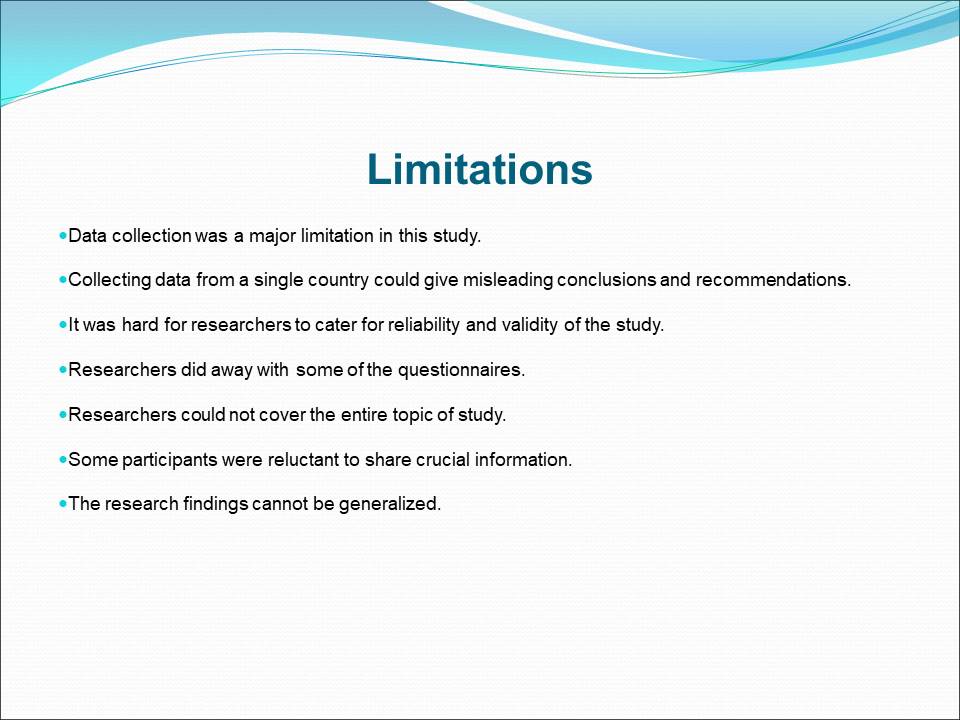
Implications/ recommendations
- The study will help the companies to formulate their future marketing strategies.
- The companies’ decision-makers should focus on corporate social responsibility and public health issues.
- PepsiCo should improve its supply chain.
- Both companies should increase their sponsorships to attract more customers.
- PepsiCo should conduct market research to assist it in decision making.
This study has presented comparative analysis of the strategies of Coca-Cola and PepsiCo, the findings of this research would assist both the companies to formulate their future strategy and would implicate the favorable features of this study that they feels more effective to conquer the strategic fights among the two. At the same time, academia and researcher working with corporate strategy would be interested to the implication of this research to engage for further research in this area.
The management, board of directors and other decision-makers of both Coca-Cola and Pepsi should concentrate on the corporate social responsibility and public health issues more carefully because the consumption of carbonated soft drinks has declined considerably because of the development of the health awareness. To increase market share in the global market, it is essential for these companies to create value for the customers in stead of maximizing profit margin because the people of developing countries like India have faced health due to consuming products of Coca-Cola and the consumers of developed countries have suffered problems because of over consumption of soft drinks.
Above discussion demonstrates that both Coca-Cola and Pepsi used similar pricing strategies, but the position of Pepsi is not suitable enough; in this context, the management should increase budget for the market research to restructure pricing strategy for different area; however, this recommendation has derived from survey reports. At the same time, the management, and board of directors of Pepsi should concentrate on the supply chain management and distribution channel to increase sales revenue because the products of Coca Cola is available in everywhere but the purchasers have to provide more effort if they like Pepsi and this scenario is common in rural areas. In addition, Coca Cola gained competitive advantage over Pepsi use advance promotional strategies, for instance, Coca Cola has long tradition to sponsor large event; therefore, the marketers of Pepsi should try to use sponsorship strategy more effectively, for instance, it should target large event like American Idol, World Cup Football, or Olympic games and so on.
The management of Pepsi should conduct more research to take effective strategic decision and implement this plan as well though it has strong presence in the global market; at the same time, this study will help the future researchers to find out loophole regarding Pepsi’s strategy and conduct research.
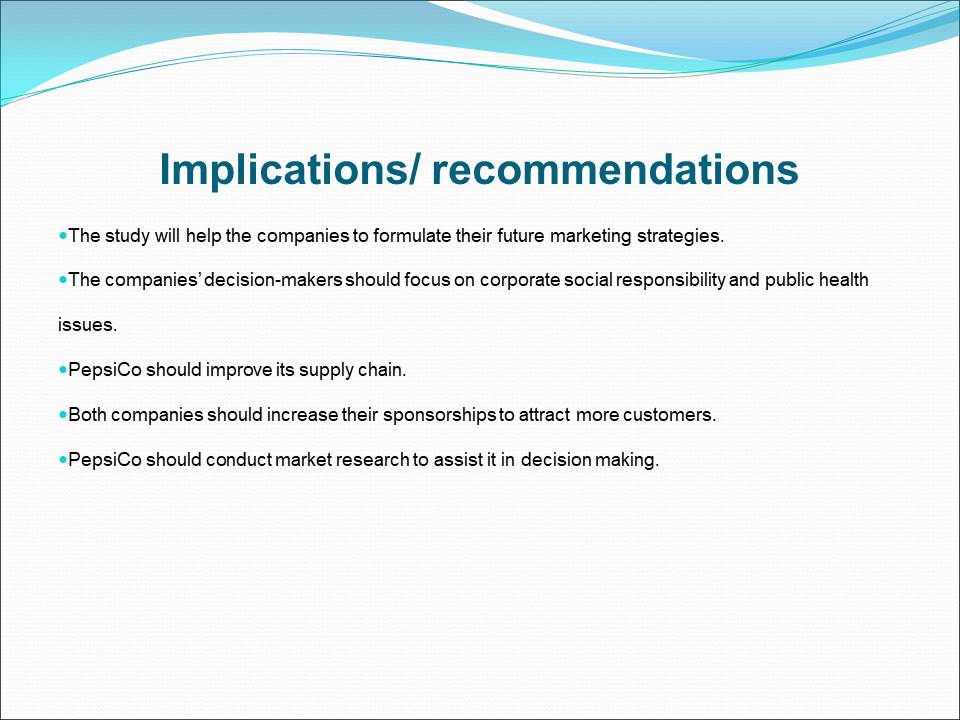
Conclusion
- Coca Cola and PepsiCo continue competing to expand their market share.
- Pepsi continues to establish itself in areas that Coca Cola dominates.
- Health concerns among the customers have affected the soft drinks market.
- The ‘Cola War’ is not likely to end soon as every company tries to increase its sales volume.
The two giant of the carbonated beverage industry has been continuing strategic fight to conquer one over another in order to attain enhanced market share for about a century where the Coca-Cola enjoys more ‘competitive advantage’ for its earlier entry but there is no reason undermine the role of PepsiCo. PepsiCo has ensured its strong presence in every market of the Cola-Cola and gained a remarkable market share allover the globe. The raising health consciousness among the people has seriously affected the soft drinks market, but it does not mean the ‘Cola-War’ would be ended, both the companies engaged to remove the associated health risk by reducing fat, calories, artificial color and preservative and their strategic fight would be continued to gain enhanced market share.
